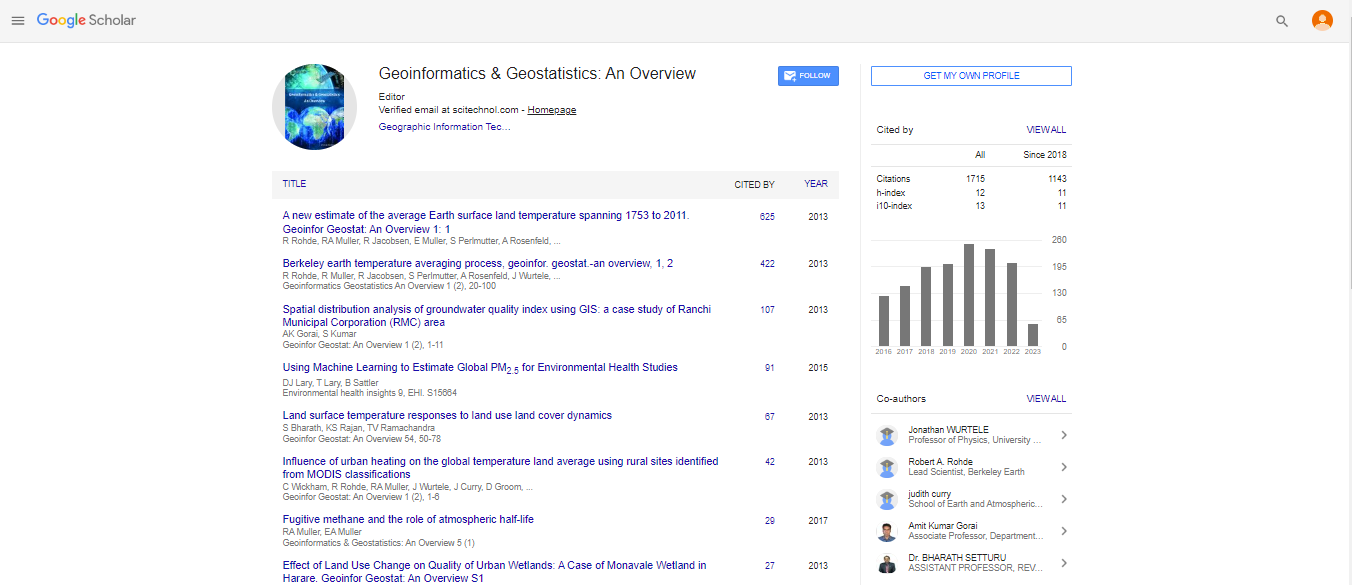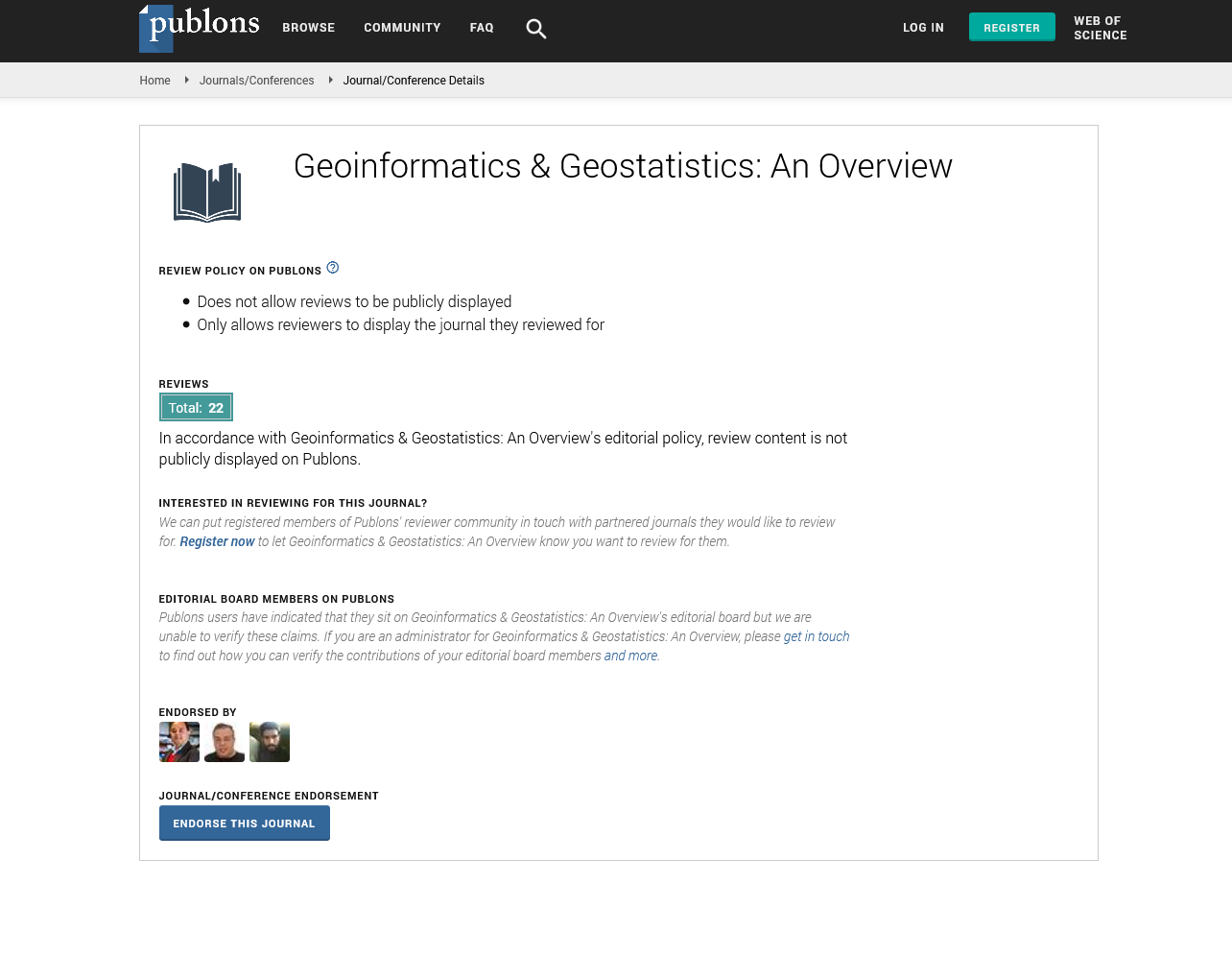Perspective, Geoinfor Geostat An Overview Vol: 12 Issue: 5
Enhancing Geoinformatics Research through Robust Spatial Data Infrastructures
Miles Archer*
1Department of Geoinformatics, University of Cape Town, Cape Town, South Africa
*Corresponding Author: Miles Archer,
Department of Geoinformatics, University
of Cape Town, Cape Town, South Africa
E-mail: milesarcher@ucth.ac.za
Received date: 23 September, 2024, Manuscript No. GIGS-24-150253;
Editor assigned date: 25 September, 2024, PreQC No. GIGS-24-150253 (PQ);
Reviewed date: 09 October, 2024, QC No. GIGS-24-150253;
Revised date: 16 October, 2024, Manuscript No. GIGS-24-150253 (R);
Published date: 23 October, 2024, DOI: 10.4172/2327-4581.1000413
Citation: Archer M (2024) Enhancing Geoinformatics Research through Robust Spatial Data Infrastructures. Geoinfor Geostat: An Overview 12:5.
Abstract
In an era marked by rapid urbanization, environmental change and technological advancement, geoinformatics has emerged as a vital field that utilising the spatial data to address complex real-world problems. Spatial Data Infrastructures (SDIs) plays important role in facilitating effective geoinformatics research, providing the necessary framework for data sharing, integration and analysis. The importance of SDIs in enhancing the capabilities of geoinformatics research, emphasizing their role in promoting collaboration, improving data accessibility and supporting informed decision-making
Description
In an era marked by rapid urbanization, environmental change and technological advancement, geoinformatics has emerged as a vital field that utilising the spatial data to address complex real-world problems. Spatial Data Infrastructures (SDIs) plays important role in facilitating effective geoinformatics research, providing the necessary framework for data sharing, integration and analysis. The importance of SDIs in enhancing the capabilities of geoinformatics research, emphasizing their role in promoting collaboration, improving data accessibility and supporting informed decision-making.
Understanding spatial data infrastructures
Spatial Data Infrastructure refers to the framework that enables the collection, management, sharing and analysis of spatial data. SDIs comprise a combination of technology, policies, standards and human resources that facilitate the use of geospatial data across various sectors. Key components of SDIs includes the following.
Data repositories: Centralized databases that store geospatial data, making it accessible to researchers and practitioners.
Standards and protocols: Guidelines that ensure data consistency, interoperability and quality across different systems and platforms.
Metadata: Descriptive information about the data sets, including their origin, format and usage, which aids in data discovery and evaluation.
Access and tools: Platforms that provide users with the tools necessary to visualize, analyze and manipulate spatial data.
Enhancing collaboration and interoperability
One of the primary advantages of SDIs is their ability to foster collaboration among various stakeholders, including government agencies, research institutions and private organizations. By providing a shared platform for data access, SDIs break down silos and encourage interdisciplinary research. For example, urban planners can collaborate with environmental scientists to analyze the impacts of land-use changes on local ecosystems, utilising spatial data from a common infrastructure.
Moreover, SDIs enhance interoperability by establishing common standards and protocols. This is essential in a field where data can come from diverse sources, including remote sensing, Geographic Information Systems (GIS) and field surveys. By adhering to standardized formats and practices, researchers can integrate data seamlessly, leading to more comprehensive analyses and insights.
Improving data accessibility and quality
SDIs significantly improve the accessibility of spatial data, which is major for effective geoinformatics research. Researchers often face challenges in obtaining high-quality, relevant data, which can hinder their ability to conduct thorough analyses. SDIs mitigate these challenges by providing centralized access to diverse data sets, ranging from topographical maps to socio-economic indicators.
Furthermore, the emphasis on metadata within SDIs enhances data quality and usability. Comprehensive metadata allows researchers to evaluate the reliability and applicability of data sets, facilitating informed choices in their analyses. This quality assurance is particularly important in research fields such as climate science and public health, where data accuracy can have significant implications for policy and practice.
Supporting informed decision-making
Informed decision-making relies heavily on the availability and analysis of spatial data. SDIs equip policymakers, urban planners and other stakeholders with the tools and information needed to make sound decisions. For instance, in disaster management, access to realtime spatial data can enhance preparedness and response efforts. SDIs can provide major information about vulnerable areas, infrastructure, and resource distribution, enabling authorities to allocate resources effectively and reducing risks.
Moreover, SDIs facilitate the use of advanced analytical techniques, such as spatial modeling and predictive analytics. These techniques enable researchers to simulate scenarios, assess potential outcomes and identify optimal strategies for addressing various challenges. For example, in environmental management, spatial models can help predict the impact of land-use changes on biodiversity, guiding conservation efforts.
Conclusion
Spatial Data Infrastructures are indispensable for effective geoinformatics research, providing the foundation for collaboration, data accessibility and informed decision-making. As the demand for geospatial data continues to grow in response to complex global challenges, the role of SDIs will become increasingly major. By promoting interoperability, enhancing data quality and supporting advanced analytical capabilities, SDIs empower researchers and decision-makers to control the full potential of spatial data. Investing in and developing robust SDIs is essential for advancing geoinformatics research and promoting sustainable solutions to pressing societal issues. As we move forward, prioritizing the establishment and maintenance of effective SDIs will be important for navigating the complexities of our increasingly interconnected world.
 Spanish
Spanish  Chinese
Chinese  Russian
Russian  German
German  French
French  Japanese
Japanese  Portuguese
Portuguese  Hindi
Hindi 
